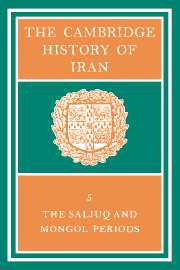Book contents
- Frontmatter
- 1 THE POLITICAL AND DYNASTIC HISTORY OF THE IRANIAN WORLD (A.D. 1000–1217)
- 2 THE INTERNAL STRUCTURE OF THE SALJUQ EMPIRE
- 3 RELIGION IN THE SALJUQ PERIOD
- 4 DYNASTIC AND POLITICAL HISTORY OF THE IL-KHĀNS
- 5 THE ISMĀ‘ĪLĪ STATE
- 6 THE SOCIO-ECONOMIC CONDITION OF IRAN UNDER THE ĪL-KHĀNS
- 7 RELIGION UNDER THE MONGOLS
- 8 POETS AND PROSE WRITERS OF THE LATE SALJUQ AND MONGOL PERIODS
- 9 THE VISUAL ARTS, 1050–1350
- 10 THE EXACT SCIENCES IN IRAN UNDER THE SALJUQS AND MONGOLS
- Bibliography
- Index
- Plate section
- References
8 - POETS AND PROSE WRITERS OF THE LATE SALJUQ AND MONGOL PERIODS
Published online by Cambridge University Press: 28 March 2008
- Frontmatter
- 1 THE POLITICAL AND DYNASTIC HISTORY OF THE IRANIAN WORLD (A.D. 1000–1217)
- 2 THE INTERNAL STRUCTURE OF THE SALJUQ EMPIRE
- 3 RELIGION IN THE SALJUQ PERIOD
- 4 DYNASTIC AND POLITICAL HISTORY OF THE IL-KHĀNS
- 5 THE ISMĀ‘ĪLĪ STATE
- 6 THE SOCIO-ECONOMIC CONDITION OF IRAN UNDER THE ĪL-KHĀNS
- 7 RELIGION UNDER THE MONGOLS
- 8 POETS AND PROSE WRITERS OF THE LATE SALJUQ AND MONGOL PERIODS
- 9 THE VISUAL ARTS, 1050–1350
- 10 THE EXACT SCIENCES IN IRAN UNDER THE SALJUQS AND MONGOLS
- Bibliography
- Index
- Plate section
- References
Summary
This chapter touches on the era of the “Great Saljuqs” only in its last phase, that is, towards the end of the reign of Sultān Sanjar (d. 552/1158), a monarch who was then decadent though he was later idealized. The Saljuqs are a remarkable phenomenon, and we should therefore cast at least a cursory glance back to the period of their real greatness; for this wholly Turkish dynasty, holding sway over an immense area, played a very considerable part in the expansion of the Persian literary language and of Persian culture in general. That the principal Saljuq rulers themselves showed a lack of culture was no obstacle to this, mainly because their internal policy was in the hands of Iranian counsellors and trusted advisers, without whose help these barbarian warriors could scarcely have held their own in such a highly cultivated milieu. Moreover the example set by the policy of Sultān Mahmūd of Ghazna had a lasting effect: the Saljuq court teemed with Iranian scholars and Iranian writers. The official language was Persian, and in it was conducted the official correspondence of the court, in contrast to the practice under Mahmūd. This is one side of the picture. On the other, the waves of Turkish expansion were hastening the influence of that language in certain areas, with Turkish idioms even beginning to approach the position of the literary language.
Whereas the expansion of the Saljuqs was to the west, embracing Syria, Asia Minor, and the Caucasus, the ousted Ghaznavids strove to establish a firm footing in Multan, the Punjab, and Sind, at the same time extending the sway of the Persian language and Persian literature in the upper social strata of their remaining Indian possessions.
- Type
- Chapter
- Information
- The Cambridge History of Iran , pp. 550 - 625Publisher: Cambridge University PressPrint publication year: 1968
References
- 4
- Cited by

